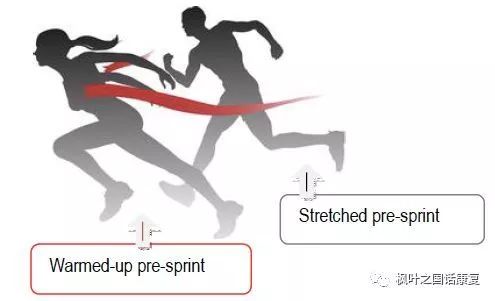Here we have an athlete preparing for a game. They’ve put on their gear and done their warmup, and now it’s time for one more routine— stretching. Typically, athletes stretch before physical activity to avoid injuries like muscle strains and tears. But does stretching actually prevent these issues? And if so, how long do the benefits of stretching last?
这位运动员正在为比赛做准备。他/她披挂整齐,做完热身运动,是时候进行最后一项例行程序了,那就是拉伸。运动员通常会在运动前拉伸,避免受伤,如肌肉拉伤或撕裂。但拉伸真的可以避免这些问题吗?如果真的可以,拉伸的效果可以持续多久呢?
To answer these questions, we need to know what’s actually happening in the body when we stretch. There are two kinds of stretching our athlete might be doing. Dynamic stretches, which are controlled movements that engage a range of muscles throughout the motion. And static stretches, where the stretcher holds a position to keep specific muscles at a fixed length and tension. Our athlete is currently doing a static hamstring stretch— a 30 second interval where he pulls his hamstring beyond its usual range of motion. However, while we often think of stretching a muscle like stretching a rubber band, muscles are actually comprised of various tissue types, which interact to make a complex material. Rubber is elastic, meaning it resists being stretched and then returns to its original shape. But muscle is viscoelastic. This means that, in addition to those elastic qualities, muscle changes under the stress of being stretched.
为了回答这些问题,我们先得了解拉伸的时候,身体里到底发生了些什么。运动员可能会进行两种拉伸。动态拉伸,即加以控制的动作,其覆盖到多块肌肉。静态拉伸,即拉伸者保持某个动作,让某块特定的肌肉保持一定长度和舒展程度。这位运动员正在进行静态腘绳肌拉伸——每隔30秒,他会将腘绳肌拉伸到其正常运动范围之外的位置。但是,虽然我们通常认为拉伸肌肉和拉扯橡皮筋差不多,但肌肉其实包含了多种细胞组织,这些组织互相作用,使肌肉成为了一种复杂的材料。橡胶有弹性,也就是说它在被拉伸的时候会抵抗,再复原成原始的形状。但肌肉有粘弹性。意思是除了弹性的特质,肌肉还会因拉伸造成的压力发生变化。
Let’s see this in action. At the large scale, this hamstring stretch is pulling on layers of protective tissue surrounding the muscle fibers, as well as the tendons that connect this muscle to nearby bones. These tissues contain elastic proteins like collagen and elastin, which allow them to slightly elongate over the duration of the stretch. At the smaller scale, these skeletal muscle fibers are comprised of millions of sarcomeres— the smallest contracting unit of muscle tissue. Sarcomere’s long, fibrous proteins can relax to elongate muscle fibers or they can contract to shorten them— pulling on tendons and protective tissue to create the force propelling our athlete’s body. And when those tissues have been stretched out, they retain their strength at longer lengths, allowing our athlete to take full advantage of his improved range of motion.
我们来看一个实例。宏观来看,这种腘绳肌拉伸会拉扯肌肉纤维周围的筋膜层,也会拉扯连接肌肉与其附近骨骼的肌腱。这些组织含有弹性蛋白,如胶原蛋白和弹性蛋白,使这些组织能够在拉伸期间稍微拉长一些。微观来看,这些骨骼肌纤维包含了上亿段肌节——肌肉组织中最小的收缩单元。肌节中的长纤维状蛋白可以松弛以舒展肌肉纤维,或收缩以拉紧肌肉纤维;拉扯肌腱和筋膜,便产生推动运动员身体的力量。在这些组织被拉伸开以后,它们就能将强度维持更长的时间,让运动员充分运用提升后的动作幅度。
Unlike a rubber band, this muscle’s resistance to stretching decreases with each 30 second stretch, allowing our athlete to continually elongate his hamstring. And this improved flexibility likely decreases the chance of incurring certain muscle injuries. But due to muscle’s elastic properties, this effect will be gone in just 10 minutes without further activity. The exercise from his match should elevate his muscle’s temperature and continue elongating the muscle, maintaining his increased flexibility throughout the game. But once he gives his hamstrings a break, they’ll retract back to their previous state.
与橡皮筋不同的是,肌肉对拉伸的阻力每拉伸30秒都会减少,让运动员得以持续伸长腘绳肌。提升后的柔韧性降低了造成某些肌肉损伤的可能性。但由于肌肉的弹性,只要没有接着运动,这个效果就会在仅仅10分钟后消失。赛场上的运动能提高他的肌肉温度,在整场比赛中持续拉长肌肉,维持他增强的柔韧性。但只要他一让腘绳肌休息一会儿,它就会收缩回原始状态。
So if all this is just temporary, how can you permanently improve your flexibility? For skeletal muscles, improved flexibility comes from additional sarcomeres, which allow you to maintain strength at even greater lengths. Sarcomeres are added and subtracted to muscles depending on how frequently they’re used, so improving overall flexibility requires a comprehensive stretching regimen. Plus, you need to stretch often— very often. Current research suggests at least 10 minutes a day for roughly two months. And since it’s unsafe to hold any stretch for too long, it’s recommended that you break up your stretching within any given session. Frequent stretching also makes lasting changes to your brain. The more you stretch a muscle, the higher your pain threshold becomes, allowing you to stretch further and further.
如果这些都是暂时的效果,那你该如何永久地提升你的柔韧性呢?就骨骼肌而言,增强的柔韧性来自更多的肌节,甚至可以让你更久地维持力量。肌肉中肌节的增减取决于肌节的使用频率,因此如果要整体提升柔韧性,就得有全面的拉伸计划。你还得经常拉伸,时常地拉伸。近期的研究建议每天至少要拉伸十分钟,大约坚持两个月。由于持续过久拉伸不太安全,建议将拉伸分段进行。频繁的拉伸也会对你的大脑产生持久的影响。你越频繁地拉伸某块肌肉,疼痛阈值就越高,让你可以更进一步拉伸。
Long-term improvements to your flexibility can provide a better range of motion for your joints, potentially reducing your risk of muscle injury in the short and long-term. But it’s also possible to stretch too much, as flexible people can move their joints in potentially dangerous ways. Stretching also isn’t helpful for every kind of movement, especially those where muscle injuries aren’t very common. For example, long distance running only involves a small range of motion for the joints involved, so stretching is unlikely to prevent that sport’s most common injuries.
柔韧性的长期改善可以为你带来更高的关节活动度,从短期、长期来看都有可能降低肌肉损伤的风险。但是拉伸过度也是有可能的,柔韧性强的人可能会以有危害的方式活动关节。拉伸也不会有助于每一种运动,尤其是肌肉损伤不太频繁的运动。比如,长跑只需要相关关节的小幅度活动,因此拉伸就不太可能预防这种运动中最常见的损伤。
When it comes down to it, different lifestyles require different kinds of mobility. And no single stretching regimen is flexible enough to fit every situation.
归根结底,不同的生活方式需要不同的活动量。没有一种拉伸的方式适用于各种情况。
限 时 特 惠: 本站每日持续更新海量各大内部创业教程,一年会员只需98元,全站资源免费下载 点击查看详情
站 长 微 信: lzxmw777






